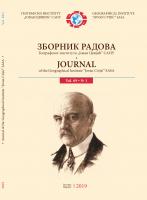FOREST FIRES IN FINLAND – THE INFLUENCE OF ATMOSPHERIC OSCILLATIONS
FOREST FIRES IN FINLAND – THE INFLUENCE OF ATMOSPHERIC OSCILLATIONS
Author(s): Milan Milenković, Vladan Ducić, Jovan Mihajlović, Dragan Burić, Violeta BabićSubject(s): Physical Geopgraphy
Published by: Географски институт »Јован Цвијић« САНУ
Summary/Abstract: In Finland, in the period 1996–2017, 28,434 forest fires were recorded (an average of 1,292.5 per year), and the total burned area was 11,922 ha (an average of 541.9 ha per year). In both cases, a statistically nonsignificant downward trend was recorded. Forest fires in Finland do not represent a particularly significant problem, primarily due to climatic characteristics, well-organized fire protection, and low density of population. The research of climate influence included the Atlantic Multidecadal Oscillation (AMO), the North Atlantic Oscillation (NAO), and the Arctic Oscillation (AO). The statistically significant values (p ≤ .05) of Pearson correlation coefficient were recorded for the August values of NAO and the surface area of burned forest (−0.44), the June values of NAO and the average surface area of forest burned per fire (−0.51) and the May AO values and the average surface area of forest burned per fire (−0.45). For the June values of NAO and the average surface area of forest burned per fire, the Lomb periodogram shows four significant peaks, and the match is at two, at 2.4 and 3.4 years, which supports the hypothesis of the connection between NAO and forest fires in Finland.
Journal: Зборник радова Географског института "Јован Цвијић" САНУ
- Issue Year: 1/2019
- Issue No: 1
- Page Range: 75-82
- Page Count: 8
- Language: English

